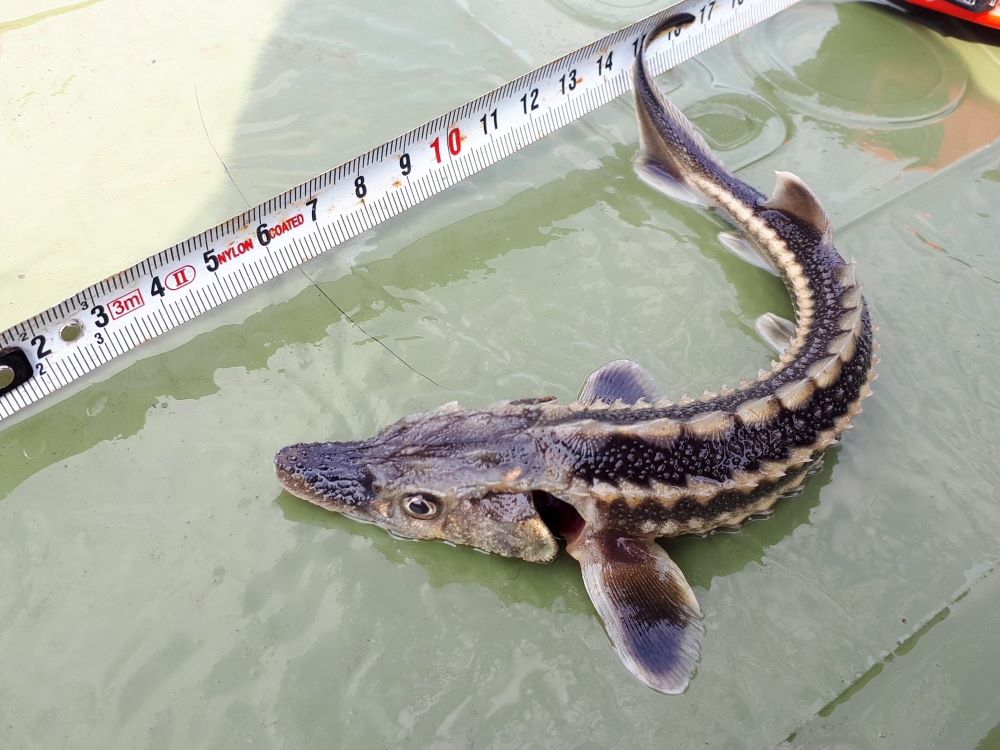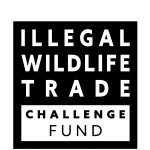Conserving Critically Endangered fish

A juvenile sturgeon is weighed and measured as part of research on the Rioni River. Credit - Tamar Edisherashvili, Fauna & Flora
Using genetic evidence to combat poaching and trafficking of wild-caught sturgeons in commercial markets in Georgia
Sturgeons (Family: Acipenseridae) are among the most endangered taxa worldwide. Often dubbed ‘modern day dinosaurs’, the incredible 200-million-year legacy of this group is being jeopardised by intensifying anthropogenic threats (i.e. caused by humans, either indirectly or directly), including illegal fishing and trade. Georgia is a hub of cultural and biological diversity, where two global biodiversity hotspots converge, and species lost elsewhere survive. Despite its relatively small territory and altered landscape, it is a globally significant hotspot for sturgeon diversity. The Rioni River and eastern Black Sea harbour some of the last sturgeon spawning and feeding grounds in Europe, supporting wild populations of at least four sturgeon species, including the Critically Endangered Ship sturgeon (Acipenser nudiventris), which was previously thought to be extinct.
Significant resources have been invested in the conservation of global sturgeon populations, including the development of commercial aquaculture programmes. These programmes are intended to improve conservation outcomes by reducing the harvest of wild populations, while still meeting commercial demand for sturgeon products. However, there is growing concern that commercial aquaculture programmes may contribute to wild population declines through continued, illegal harvest and the escape and/or release of captive individuals into wild environments.

Evidence gathering to shed light on illegal trade presents numerous challenges. In Georgia, rearing and selling farmed sturgeon is legal, whereas wild sturgeon are protected under the law, and their capture and trade is illegal. From an illegal trade perspective, the distinction between farmed and wild sturgeon presents a number of challenges, including the reliable identification of illegally captured, wild sturgeon at the point of sale. Recent leaps in evolutionary biology and conservation genetics now offer powerful insights into wildlife crime, with novel methods elucidating the trade of wild sturgeon for the first time in Georgia. With support from the Illegal Wildlife Trade Challenge Fund, Fauna & Flora has partnered with Ilia State University, U.S. Geological Survey Eastern Ecological Science Centre, Delaware State University, and San Diego State University, to investigate the potential threat of captive culture on wild sturgeon populations in Georgia. This team of local and international experts, led by Dr Tamar Beridze, used mitochondrial DNA sequencing and microsatellite analyses to identify the species and origin of sturgeon sold commercially in Georgia.

Findings from the microsatellite analyses showed a significant difference between wild and farmed Russian sturgeon (Acipenser gueldenstaedtii) populations, with farmed Russian sturgeon found to be genetically distinct from the local, wild Russian sturgeon population. Exposing the potential for wild-caught individuals to be present in coastal and commercial markets in Georgia, this methodology offers a possible means to differentiate between farmed and wild individuals. The findings also highlight another possible threat to Georgia’s sturgeon: the risk of genetic pollution from aquaculture (due to escape or release), including hybridisation of farmed sturgeon with wild sturgeon. Overall, the results suggested that wild sturgeon populations may still be exploited to support captive aquaculture programmes and commercial sales – a crucial piece of evidence that helps cement understanding of the illegal trade of this imperilled group in Georgia and regionally. Further, these findings highlight the need for continued, productive engagement with Georgia’s commercial fisheries and aquaculture sectors as key actors in sturgeon conservation in the Black Sea and Rioni River.
The full article, ‘Genetic Evidence for the Presence of Wild-Caught Sturgeons in Commercial Markets in Georgia’, has been published in Diversity.
Written by Dr Tamar Beridze, Tamari Edisherashvili and Bianca Roberts. For more information on this IWT Challenge Fund Main project IWT082, led by Fauna & Flora’s Caucasus Programme, please click here.

 Back
Back